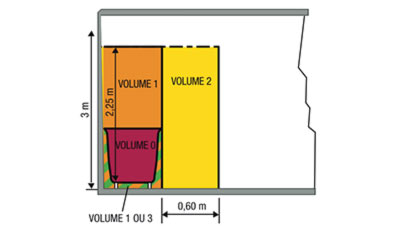
-
1. Garden
Be careful with the cords of electric lawnmowers and other power tools, always keeping the cord behind your direction of movement. Never operate electrical equipment in the rain. All outdoor power outlets around your home must be protected by a 30mA Residual Current Device (RCD). -
2. Outlets
Faulty or broken outlets present a significant risk of electric shock. Have your electrician replace any broken or loose outlets immediately. Socket outlets must be equipped with automatic shutters, secured by screws in the flush box and have high shock resistance. All outlets should be protected by a 30mA Residual Current Device (RCD). -
3. Large appliances
Hot water systems, washing machines, and ovens all have large sheet metal surfaces. If there are any internal defects, the slightest touch of their exterior surface could be hazardous or even deadly. Ensure all large appliances (e.g. hot water system) are earthed via the green-yellow wire. -
4. Changing lightbulbs
Turning off the light switch does not make it safe to change a lightbulb. Always unplug the device from the power outlet, or disconnect it at the switchboard. Wall switches do not provide the necessary safety conditions. All lighting circuits in your home must be protected by a 30mA Residual Current Device (RCD). -
5. Small appliances
Lighting, alarm clocks and other portable devices can easily be knocked or dropped against hard surfaces. If this happens, the casings may crack, potentially exposing dangerous wiring and other parts. All mobile and other portable devices must bear the ‘Class II’ symbol. -
6. Bathroom
The bathroom is the most dangerous room in the home because when your skin is wet it’s extremely sensitive to electric current. Dry hands thoroughly before handling an appliance, and never use one that is damaged. All switches and outlets in a bathroom must be protected by a 30mA Residual Current Device (RCD).
1. Garden
2. Outlets
3. Large appliances
4. Changing lightbulbs
5. Small appliances
6. Bathroom
RCDs: Your ultimate protection from electrocution
Residual current devices (RCDs) / ground fault circuit interrupters detect electrocution currents and cut power off immediately. They are now mandatory according to the IEC 60634 electrical safety standard on all circuits supplying:
• Power outlets
• Lighting
• All devices in bathrooms and wet areas
Get safe! Check that your home’s electrical panel / breaker box for RCDs , is easy to identify, is equipped with:
• A white pushbutton
• A "30mA" marking
If there are RCDs fitted in your home electrical panel, check if they are working by pushing the “test” button. The RCD should trip.
If you don’t see any RCDs fitted, you need to upgrade your home electrical panel with RCDs to ensure the highest level of protection throughout your home.
Four areas in your home that need your attention
1. Switchboard
Your switchboard protects your home from electrical fires caused by short-circuits and overloads.
For your safety, your switchboard must be:
• Sheltered from water
• Made from high quality materials
• Highly resistant to shocks
There should not be any holes that are large enough to insert a tool or finger. There should also be a closing cover to protect all circuit breakers. Teamed with RCDs, your switchboard can now also protect your family from electrocution.
2. Switches and outlets
Use quality switches and outlets as these items are vital for your safety:
• Outlets equipped with automatic shutters to prevent children from inserting fingers or objects into the holes
• All plastic parts must be strong enough to withstand blows
• All lighting and power grids screwed securely to mounting brackets
All switches and outlets in your home must be protected by a 30mA Residual Current Device (RCD).
> Check out our switches and socket ranges
Replace faulty components:
Replace any outlets, light fittings, extension leads and appliances that are showing any signs of wear and tear, including cracks, sticking or lose switches, and split or crushed electrical leads.
Safety first :
If you do this on your own, always wear protective gloves, use insulated tools, and switch the power off at the switchboard.
3. Lighting devices
Lighting devices housed in insulating material must have the ‘Class II’ symbol engraved on them.
Modern lighting, including bare cables, must be supplied by a transformer bearing the ‘Safety Extra Low Voltage’ symbol.
Metal structured chandeliers must be linked to a "protective earth" via the “green-yellow” wire.
All lighting circuits in your home must be protected by a 30mA Residual Current Device (RCD)
4. Bathrooms
The bathroom is the most dangerous room in the home. Why? Because when your skin is wet, your body is extremely sensitive to electric current.
Safety standards
Volume 0: No electrical parts at all
Volume 1: within reach from the bath or shower with arms up
• Only 12V isolated fittings (SELV* supply)
Volume 2: maximum reach from the bath or shower
• Transformer isolated sockets (“razor” type)
• Class II insulated lighting and heaters
All switches and outlets in your bathrooms must be protected by a 30mA Residual Current Device (RCD).
How to get support from your electrician






